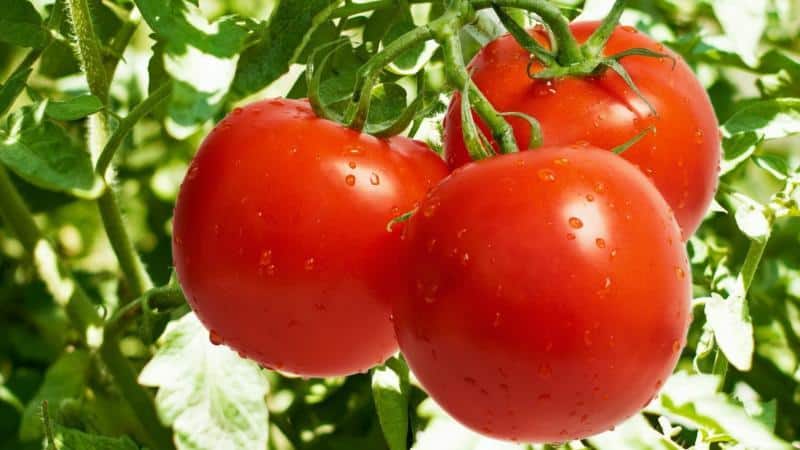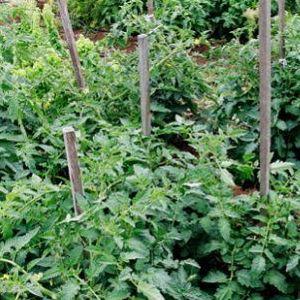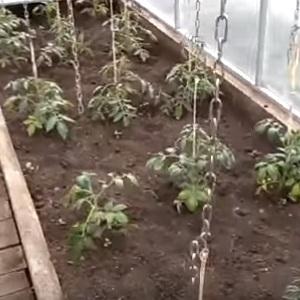Methods for gartering tomatoes in open ground: how to do it correctly and is it necessary at all?
After planting in the ground, tomato bushes begin to grow actively. When growing green mass, many varieties require additional care - attaching the plant to a support. Let's look at how to properly tie tomatoes in an open ground.
Why tie up tomatoes?
Not all tomato bushes require staking. Stocky, low-growing plants with medium-sized fruits do not need this. They will grow well and produce crops without it. But tall plants, bushes with thin or weakened stems, and large fruits require additional attention and care.
Here are some reasons that support the benefits of tying tomatoes:
- If you neglect the garter, the plant may not be able to withstand a sharp increase in the load on the stem during the period of active growth of green mass or fruits. The stem will break.
- Bushes attached to supports are easier to care for (feed, water, pruning).
- Air circulates freely between tied plants and sunlight penetrates, which is necessary for the full development of tomatoes.
- Bushes that do not come into contact with the soil with their leaves, stems and fruits are less likely to get sick and are less likely to be affected by pests.
- The fruits will grow clean and will not rot from contact with wet soil.
Let's reveal a few secrets on how best to tie up tall tomatoes.
Do I need to tie up tomato bunches?
This procedure is not required.If the bush itself is attached to a support, this is usually enough for the plant to support its weight, even if the bushes are tall. But if you grow large-fruited tomato varieties, it is better to take care of gartering the fruit clusters. Tying up large tomatoes means helping the plant to hold harvest.
Experienced gardeners advise making gauze bags to quickly tie up bunches. Attach brushes with large tomatoes to the stem or to external supports.

What to tie
To attach tomatoes to supports, it is better to use soft materials that will not injure the plant stem:
- strips of fabric;
- leg-split;
- rope;
- bulky knitting yarn;
- sewing braid;
- strips of nylon stockings or tights.
Attention! It is not advisable to use thin threads, fishing line or wire when tying plants. These materials will cut into the stems and harm the tomatoes.
What to tie it to
The choice of garter method depends on the materials at hand, as well as financial capabilities. There are many ways to garter tomatoes, let’s consider them in order.
On the pegs
 This is the most common way to garter tomatoes in open ground.
This is the most common way to garter tomatoes in open ground.
Pegs fit:
- wooden;
- metal;
- plastic.
Pegs are stuck into the soil at the base of the stem, and then the plant itself is tied to the support. The number of supports is one or two per bush.
The optimal length of the stake should exceed the maximum height of an adult tomato bush. Garter tapes are wrapped around the tomato stem, starting from the ground and moving up to the top of the plant.
Important! Before staking tomatoes, experienced gardeners recommend tearing off the lower leaves of the plants so that there is no additional contact of the bush with the ground.
On the trellises
 Gardeners erect trellises by digging several supports in a row - usually tall slats or stakes. Horizontal ones are laid between the vertical supports. This is what the trellises look like in the photo:
Gardeners erect trellises by digging several supports in a row - usually tall slats or stakes. Horizontal ones are laid between the vertical supports. This is what the trellises look like in the photo:
Tomato bushes are attached to supports with garter material.
Some tomato growers believe that it is better to wrap the garter material around the plant clockwise.
This is due to the fact that the sun moves clockwise, and the tomatoes turn after it.
On a wire frame
This method of tying tomatoes is suitable for those who have few tomato bushes growing on their plot (due to the high cost of materials). It allows you to tie up tomatoes in the garden without stakes.
You can buy this frame ready-made or weave it yourself if you have wire. It looks like a cage with tomato bushes (usually one to three) planted inside it.
Important! When tying tomatoes, it is better not to tighten the garter strips tightly. It is also recommended to attach the bush in several places. This will eliminate the risk of damage to the plant.
To the chain link fence
Another way to garter tomatoes without sticks. It involves tying bushes to a fence made of metal or plastic mesh. The support grid is pulled over the stakes between the tomato rows.
Plants are attached to the mesh fence with garter material.
Important! Professional tomato growers do not recommend using the same garter material for several years in a row, since it gradually becomes a source of tomato diseases.
On hooks and chains
 Another way of gartering. But more often it is used in greenhouses made of polycarbonate.
Another way of gartering. But more often it is used in greenhouses made of polycarbonate.
It consists of lowering a chain to a vertical support above the tomato bushes.The tomato bush is attached to the links of the chain on a garter, at the end of which a hook is installed.
As the plant grows, the hook is moved to higher rings of the chain.
The method can be adapted for use in open ground if the chain is vertically lowered from supports installed between growing tomato bushes.
Let's sum it up
Do I need to tie up tomatoes in open ground? It all depends on the variety and height of the bush. Tying tomatoes is one of the important stages of caring for tall plants to obtain a good harvest.
Many methods have been invented for attaching stems to supports in open ground, and each tomato grower chooses the most convenient one for himself. Most often, when tying up bushes, they make do with improvised means - stakes, wooden slats and sticks, strips of old fabric or unnecessary nylon tights. Tomatoes they are tied in the garden without stakes, using a mesh or wire frame. When attaching bushes to supports, it is important not to use materials that can damage the plants (thin threads, fishing line or wire). The considered methods of tying are suitable not only for growing tomatoes in open ground, but also for a greenhouse.